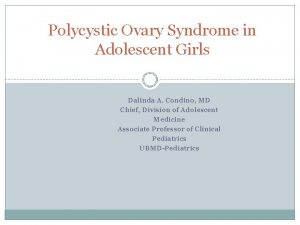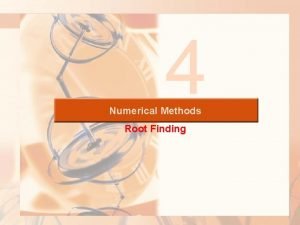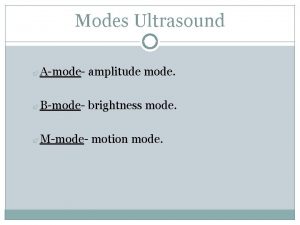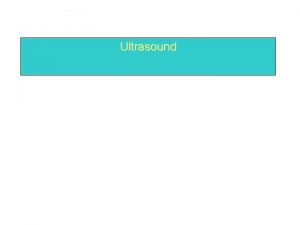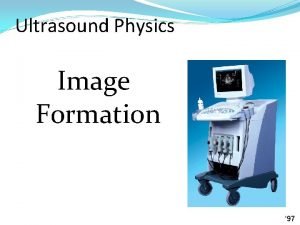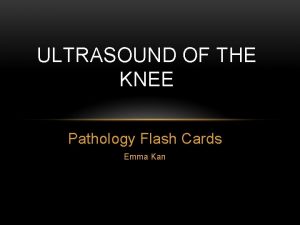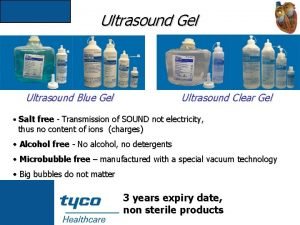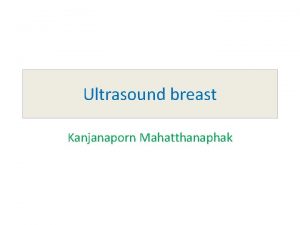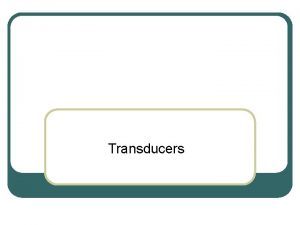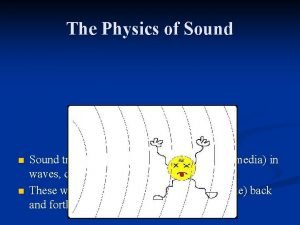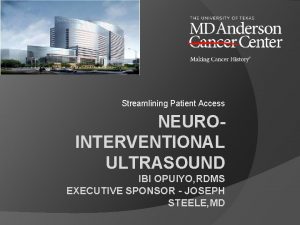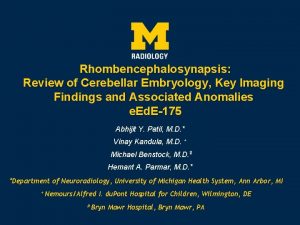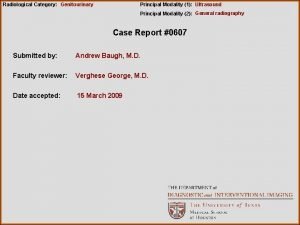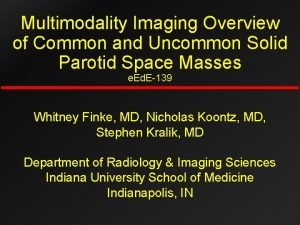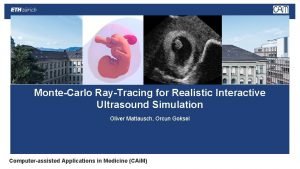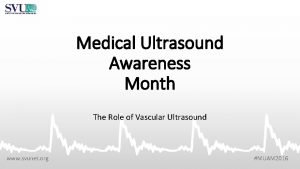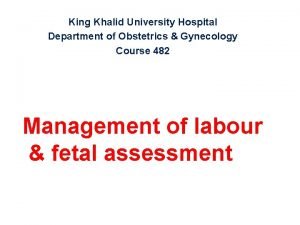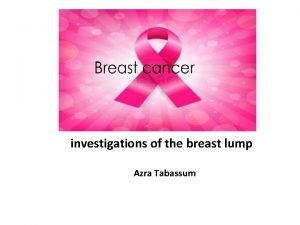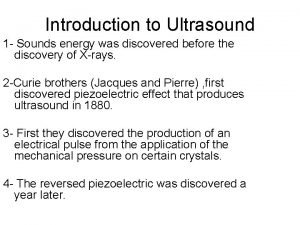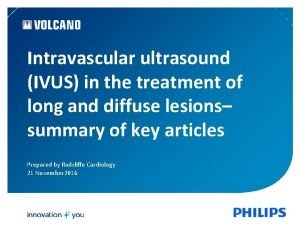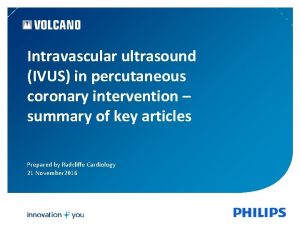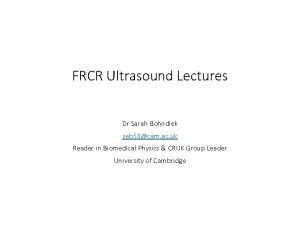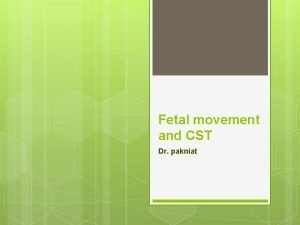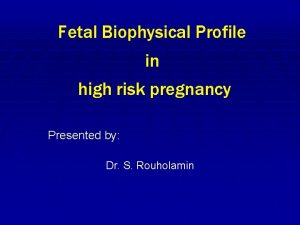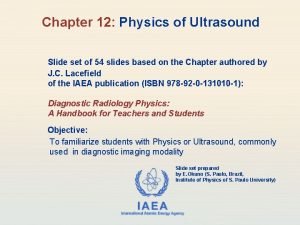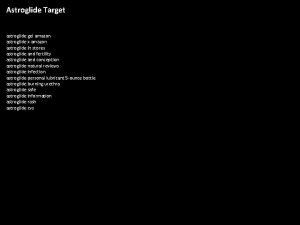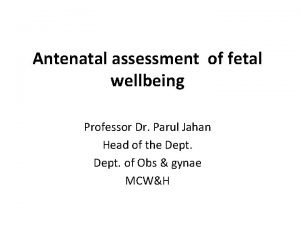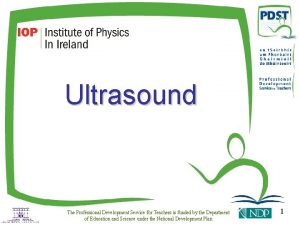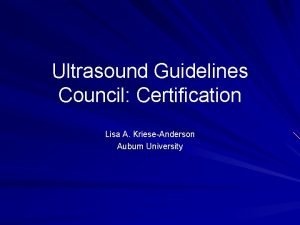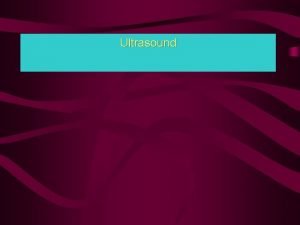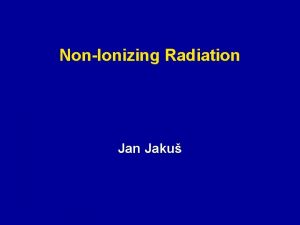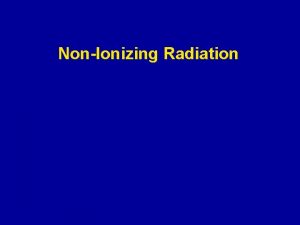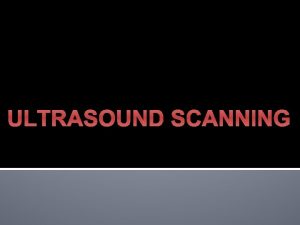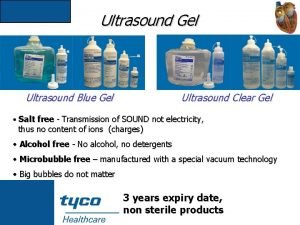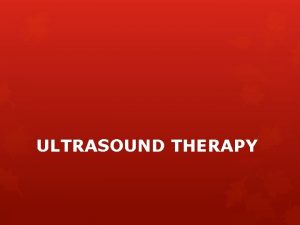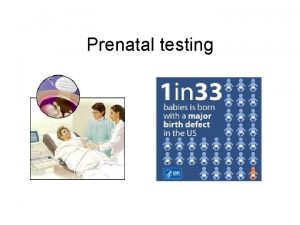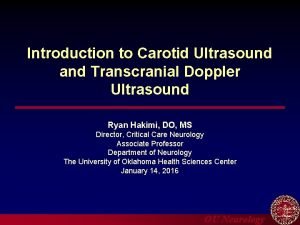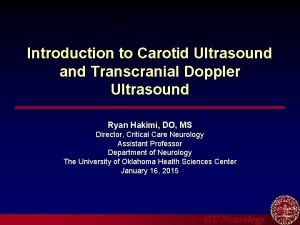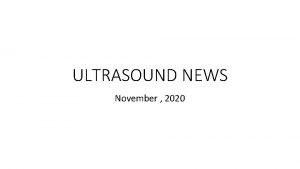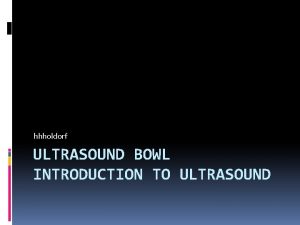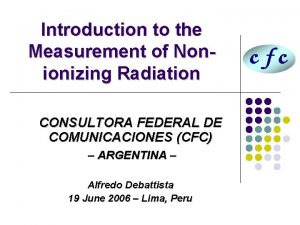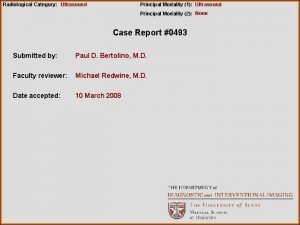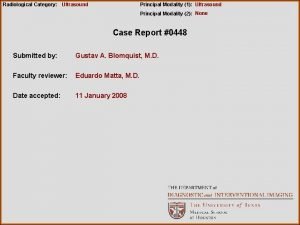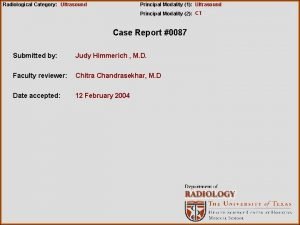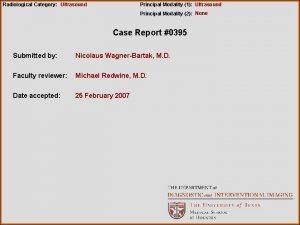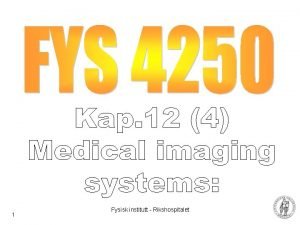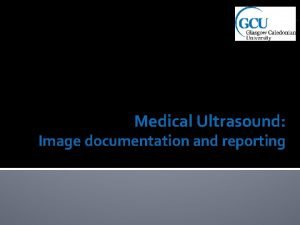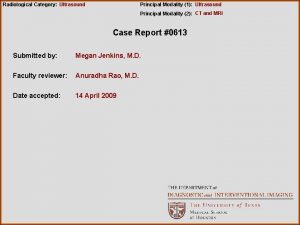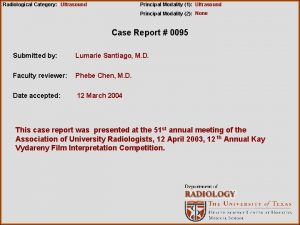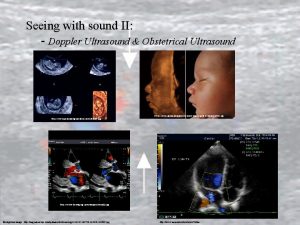Introduction Ultrasound is a nonionizing method which uses

































- Slides: 33


Introduction Ultrasound is a non-ionizing method which uses sound waves of frequencies (2 to 10 MHz) exceeding the range of human hearing for imaging Medical diagnostic ultrasound uses ultrasound energy and the acoustic properties of the body to produce an image from stationary and moving tissues Ultrasound is used in pulse-echo format, whereby pulses of ultrasound produced over a very brief duration travel through various tissues and are reflected at tissue boundaries back to the source

Introduction Returning echoes carry the ultrasound information that is used to create the sonogram or measure blood velocities with Doppler frequency techniques Along a given beam path, the depth of an echoproducing structure is determined from the time between the pulse-emission and the echo return, and the amplitude of the echo is encoded as a gray-scale value In addition to 2 D imaging, ultrasound provides anatomic distance and volume measurements, motion studies, blood velocity measurements, and 3 D imaging

1. Characteristics of Sound Frequency (f) is the number of times the wave oscillates through a cycle each second (sec) (Hertz: Hz or cycles/sec) Infra sound < 15 Hz Audible sound ~ 15 Hz - 20 k. Hz Ultrasound > 20 k. Hz; for medical usage typically 2 -10 MHz with specialized ultrasound applications up to 50 MHz period ( ) - the time duration of one wave cycle: = 1/f

1. Characteristics of Sound Speed The speed or velocity of sound is the distance travelled by the wave per unit time and is equal to the wavelength divided by the period (1/f) speed = wavelength / period speed = wavelength x frequency c = f c [m/sec] = [m] * f [1/sec] Speed of sound is dependent on the propagation medium and varies widely in different materials

1. Characteristics of Sound Speed A highly compressible medium such as air, has a low speed of sound, while a less compressible medium such as bone has a higher speed of sound The difference in the speed of sound at tissue boundaries is a fundamental cause of contrast in an ultrasound image

1. Characteristics of Sound Wavelength, Frequency and Speed The ultrasound frequency is unaffected by changes in sound speed as the acoustic beam propagates through various media. Thus, the ultrasound wavelength is dependent on the medium (c = f ) A change in speed at an interface between two media causes a change in wavelength Higher frequency sound has shorter wavelength

1. Characteristics of Sound Wavelength, Frequency and Speed Ultrasound wavelength determines the spatial resolution achievable along the direction of the beam A high-frequency ultrasound beam (small wavelength) provides superior resolution and image detail than a lowfrequency beam However, the depth of beam penetration is reduced at high frequency and increased at low frequencies

1. Characteristics of Sound Wavelength, Frequency and Speed For thick body parts (abdomen), a lower frequency ultrasound wave is used (3. 5 to 5 MHz) to image structures at significant depth For small body parts or organs (thyroid, breast), a higher frequency is employed (7. 5 to 10 MHz)

D 63. The wavelength of a 2 MHz ultrasound beam is ____ mm. A. 0. 02 B. 0. 55 C. 0. 77 D. 2. 0 E. 5. 0

D 63. The wavelength of a 2 MHz ultrasound beam is ____ mm. A. 0. 02 B. 0. 55 C. 0. 77 (Answer) D. 2. 0 E. 5. 0 C Wavelength λ = c / f The average velocity in tissue is 1540 m/sec. Frequency = 2 x 106 /sec = 1540 m/sec / 2 x 106 /sec = 770 x 10 -6 m = 0. 77 mm

1. Characteristics of Sound Pressure, Intensity and the d. B scale The amplitude of a wave is the size of the wave displacement Larger amplitudes of vibration produce denser compression bands and, hence, higher intensities of sound. Intensity of ultrasound • is the amount of power (energy per unit time) per unit area proportional to the square of the pressure amplitude, I P 2 units of milliwatts/cm 2 or m. W/cm 2 • is measured in decibels (d. B) as a relative intensity • (Losses) d. B = 10 log 10 (I 2/I 1) or d. B = 20 log 10 (P 2/P 1) • I 1 and I 2 are intensity values • P 1 and P 2 are pressure or amplitude variations

1. Characteristics of Sound Pressure, Intensity and the d. B scale

1. Characteristics of Sound Pressure, Intensity and the d. B scale Example: Calculate the remaining intensity of a 100 -m. W ultrasound pulse that loses 30 d. B while traveling through tissue. Relative Intensity (d. B)

1. Characteristics of Sound – Key Points Propagation of sound - Key Points • Speed of sound is dependent on the medium • Ultrasound frequency is independent of the medium, and does not change • Wavelength changes with the changes of speed c [m/sec] = [m] * f [1/sec] For most calculations, the average speed of sound in soft tissue=1540 m/sec, In air = 330 m/sec and in fatty tissue = 1450 m/sec

2. Interactions of Ultrasound with Matter Ultrasound interactions are determined by the acoustic properties of matter As ultrasound energy propagates through a medium, interactions that occur include reflection refraction scattering Absorption (attenuation)

2. Interactions of Ultrasound with Matter Acoustic Impedance, Z is equal to density of the material times speed of sound in the material in which ultrasound travels, Z = c = density (kg/m 3) and c = speed of sound (m/sec) measured in rayl (kg/m 2 sec) Air and lung media have low values of Z, whereas bone and metal have high values Large differences in Z (air-filled lung and soft tissue) cause reflection, small differences allow transmission of sound energy The differences between acoustic impedance values at an interface determines the amount of energy reflected at the interface

2. Interactions of Ultrasound with Matter Reflection A portion of the ultrasound beam is reflected at tissue interface The sound reflected back toward the source is called an echo and is used to generate the ultrasound image The percentage of ultrasound intensity reflected depends in part on the angle of incidence of the beam As the angle of incidence increases, reflected sound is less likely to reach the transducer

2. Interactions of Ultrasound with Matter Reflection Sound reflection occurs at tissue boundaries with differences in acoustic impedance The intensity reflection coefficient, R = Ir/Ii = ((Z 2 – Z 1)/(Z 2 + Z 1))2 The subscripts 1 and 2 represent tissues proximal and distal to the boundary. Equation only applies to normal incidence The transmission coefficient = T = 1 – R T = (4 Z 1 Z 2)/(Z 1+Z 2)2

Diagnostic Question D 54. Approximately what fraction of an ultrasound beam is reflected from an interface between two media with Z values of 1. 65 and 1. 55? A. 1/2 B. 1/10 C. 1/100 D. 1/500 E. 1/1024 R = ((Z 2 – Z 1)/(Z 2 + Z 1))2 = (1. 65 -1. 55) 2 / (1. 65 + 1. 55)2 = 1/1024

Diagnostic Question D 58. Ultrasound moves with the highest velocity in: medium Z A. Fat 1. 38 × 106 B. Blood 1. 61 × 106 C. Muscle 1: 70 × 106 D. Bone 7. 80× 106

2. Interactions of Ultrasound with Matter Tissue reflections • • • Air/tissue interfaces reflect virtually all of the incident ultrasound beam Gel is applied to displace the air and minimize large reflections Bone/tissue interfaces also reflect substantial fractions of the incident intensity Imaging through air or bone is generally not possible • The lack of transmissions beyond these interfaces results in an area void of echoes called shadowing In imaging the abdomen, the strongest echoes are likely to arise from gas bubbles Organs such as kidney, pancreas, spleen and liver are comprised of sub-regions that contain many scattering sites, which results in a speckled texture on images Organs with fluids such as bladder, cysts, and blood vessels have almost no echoes (appear black)

2. Interactions of Ultrasound with Matter Refraction is the change in direction of an ultrasound beam when passing from one medium to another with a different acoustic velocity, Wavelength changes causing a change in propagation direction (c = f) sin( t) = sin( i) * (c 2/c 1), Snell’s law; for small ≤ 15 o: t = i * (c 2/c 1) When c 2 > c 1, t > i , When c 1 > c 2, t < i Ultrasound machines assume straight line propagation

2. Interactions of Ultrasound with Matter Scatter Acoustic scattering arises from objects within: v tissue that are about the size of the wavelength of the incident beam or smaller, v represent a rough or nonspecular reflector surface As frequency increases, the non-specular (diffuse scatter) interactions increase, resulting in an increased attenuation and loss of echo intensity Scatter gives rise to the characteristic speckle patterns of various organs, and is important in contributing to the grayscale range in the image

2. Interactions of Ultrasound with Matter Attenuation Ultrasound attenuation, the loss of energy with distance travelled, is caused chiefly by scattering and tissue absorption of the incident beam (d. B) The intensity loss per unit distance (d. B/cm) is the attenuation coefficient v Rule of thumb: attenuation in soft tissue is approx. 1 d. B/cm/MHz v The attenuation coefficient is directly proportional to and increases with frequency Attenuation is medium dependent

2. Interactions of Ultrasound with Matter – Key Points Acoustic Impedance, Z is equal to density of the material times speed of sound in the material in which ultrasound travels, Z= c = density (kg/m 3) and c = speed of sound (m/sec) As ultrasound energy propagates through a medium, interactions that occur include reflection refraction scattering Absorption (attenuation)

3. Transducers • A transducer is a device that can convert one form of energy into another • Piezoelectric transducers convert electrical energy into ultrasonic energy and vice versa • Piezoelectric means pressure electricity

3. Transducers High-frequency voltage oscillations are produced by a pulse generator and are sent to the ultrasound transducer by a transmitter The electrical energy causes the piezoelectric crystal to momemtarily change shape (expand contract depending on current direction)

3. Transducers 1. This change in shape of the crystal increases and decreases the pressure in front of the transducer, thus producing ultrasound waves 2. When the crystal is subjected to pressure changes by the returning ultrasound echoes, the pressure changes are converted back into electrical energy signals 3. Return voltage signals are transferred from the receiver to a computer to create an ultrasound image 4. Transducer crystals do not conduct electricity but are coated with a thin layer of silver which acts as an electrode

3. Transducers The piezoelectric effect of a transducer is destroyed if heated above its temperature limit Transducers are made of a synthetic ceramic (peizoceramic) such as lead-zirconate-titanate (PZT) or plastic polyvinylidence difluoride (PVDF) or a composite A transducer may be used in either pulsed or continuouswave mode A transducer can be used both as a transmitter and receiver of ultrasonic waves

3. Transducers The thickness of a piezoelectric crystal determines the resonant frequency of the transducer The operating resonant frequency is determined by the thickness of the crystal equal to ½ wavelength (t= /2) of emitted sound in the crystal compound Resonance transducers transmit and receive preferentially at a single “center frequency”

3. Transducers Damping Block The damping block absorbs the backward directed ultrasound energy and attenuates stray ultrasound signals from the housing It also dampers (ring-down) the transducer vibration to create an ultrasound pulse with a short spatial pulse length, which is necessary to preserve detail along the beam axis (axial resolution)

3. Transducers Q factor The Q factor is related to the frequency response of the crystal The Q factor determines the purity of the sound and length of time the sound persists, or ring down time Q = operating frequency (MHz) / bandwidth (width of the frequency distribution) Q = f 0/BW High-Q transducers produce a relatively pure frequency spectrum Low-Q transducers produce a wider range of frequencies
 Ferriman-gallwey scale
Ferriman-gallwey scale Successive approximation method in numerical methods
Successive approximation method in numerical methods A mode ultrasound uses
A mode ultrasound uses Advantages of symposium
Advantages of symposium Piezoelectric effect ultrasound
Piezoelectric effect ultrasound Rejection ultrasound physics
Rejection ultrasound physics Pathology
Pathology Composition of ultrasound gel
Composition of ultrasound gel Anti radial vs radial ultrasound
Anti radial vs radial ultrasound Focal depth ultrasound
Focal depth ultrasound What is nn in physics
What is nn in physics Neurointerventional ultrasound
Neurointerventional ultrasound Cerebral peduncle ultrasound
Cerebral peduncle ultrasound Hypoechoic ultrasound
Hypoechoic ultrasound Pcos ultrasound report
Pcos ultrasound report Antenatal investigations
Antenatal investigations Warthin's tumor ultrasound images
Warthin's tumor ultrasound images Interactive ultrasound simulator
Interactive ultrasound simulator Svunet
Svunet Biophysical profile
Biophysical profile How to do self breast examination for cancer
How to do self breast examination for cancer Piezoelectric effect ultrasound
Piezoelectric effect ultrasound Ivus
Ivus Intravascular ultrasound
Intravascular ultrasound Beam focusing in ultrasound
Beam focusing in ultrasound Nst ultrasound
Nst ultrasound Biophysical profile score
Biophysical profile score Half life of ast
Half life of ast Ultrasound beam attenuation
Ultrasound beam attenuation Astroglide meaning
Astroglide meaning Bpp scoring
Bpp scoring Siemens ultrasound roadshow
Siemens ultrasound roadshow How does ultrasound work
How does ultrasound work Ultrasound guidelines council
Ultrasound guidelines council
